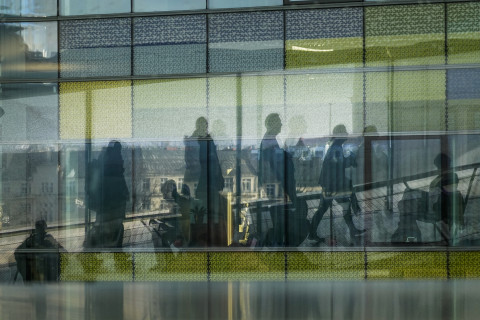The doctoral dissertation in the Culture Research will be examined at the Philosophical Faculty at Joensuu Campus and online.
What is the topic of your doctoral research, Sandi Abram?
The study addresses the question of how people established and transformed their sensory relationships to the urban environment of the Slovenian capital Ljubljana from the mid-19th century to the present day. The study attempted to examine three processes that have driven the sensory transformations of urban space in Ljubljana since the mid-1850s, namely urban modernisation, industrialisation and touristification. On the one hand, the dissertation is a historical account of the development of Ljubljana, showing the sensory layers and their embeddedness in the broader socio-political and urban processes. On the other hand, it is an account of intergenerational sensing of urban places and their transformations.
What are the key findings or observations of your doctoral research?
The doctoral research helps to answer the question of how people, individually and collectively, remember the transformed urban space in terms of sensory perception.
In this context, the thesis proposes two key notions: modernisation of the senses and industrialisation of the senses. Both notions are used to trace the bodily, sensory perceptions of urban space that underwent significant changes in socio-economic structure. Both the modernisation of the senses and the industrialisation of the senses are explored in more detail in the period of socialist Ljubljana, especially between 1940s – 1960s. The narratives of older participants, shared with their grandchildren during the sensobiographic walks, represent first-hand recollections of the production of the new sensory atmospheres in early socialist Yugoslavia. The analysis of their narratives documents the shifting perceptual registers, when rapid industrialisation, modernisation and urbanisation acted as flagships of the social revolution. The ethnography thus demonstrates how the establishment of socialist spaces solidified socialist senses.
Another key finding is pertinent to the last period studied, namely contemporary Ljubljana. The chapter looks at how the mass tourism industry shifted everyday sensory experiences in the Old Town. Drawing on sensory (auto)ethnography, the analysis shows the ways in which consequences of urban touristification not only reconfigured the historical quarter but also profoundly influenced the perception of public space in Ljubljana. I proposed the term ‘sensoryfication of place’ to denote this contemporary deployment of commodity-oriented hyper-aestheticization and spectacularization techniques and technologies in public space that aim to shape gentrified urban atmospheres as places of sensory-affective enticement.
What are the key research methods and materials used in your doctoral research?
First, for the period before the Second World War, I analysed illustrative case studies as a productive point-of-entry into the intimate texture of past sensory experiences. Likewise, I reassessed classical and modern ethnological, sociological, anthropological, architectural and urbanist texts about Ljubljana from the perspective of sensory experiences. In other words, I initially combined microhistory and discourse analysis to contextualize the secondary data analysis, i.e., memoirs, newspaper articles, literary works, paintings, historiographies, etc. In the next empirical chapter, I introduced the new ethnographic methodology of sensobiographic ethnography. In particular, I analyzed the ethnographic material generated by the novel method of transgenerational sensobiographic walking method as a method of the urban sensory ethnography developed by Prof. Helmi Järviluoma. On the one hand, the ethnographic material illuminates the time- and generation-specific sensory experiences and transformations or urban space. On the other hand, urban sensory ethnography represents a starting point for the cross-fertilisation between experimental methods, multimodal analysis, and collaborative ethnography. For example, experimental multimodal presentations of ethnographic work, including the creosote-scented appendix, soundscape recordings, gustemological presentations, spherical VR videos, recipes, soundscape compositions, photo-essays, sensobiographic fly-by animations, and sensory maps, complement the written thesis.
The doctoral dissertation of Sandi Abram, MA, entitled Sensory Capital: Sensing Transformations in Ljubljana, 1850s–2020 will be examined at the Philosophical Faculty. The opponent will be Professor David Howes (Concordia University, Canada) and the custos will be Professor Helmi Järviluoma-Mäkelä (University of Eastern Finland). Language of the public defence is English.
Public examination
Photo available for download
Further information: sandi.abram(at)uef.fi


